The Bundeswehr in the Cold War
After its establishment, the Bundeswehr grew into its role as a military power in Central Europe. However, it did not achieve its initially intended force level of 500,000 until the end of the 1960s.
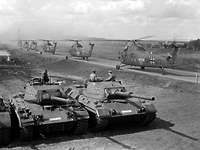


After its establishment, the Bundeswehr grew into its role as a military power in Central Europe. However, it did not achieve its initially intended force level of 500,000 until the end of the 1960s.

It all started on 2 January 1956: the first military personnel started their service in the training companies of the Air Force in Nörvenich and the Navy in Wilhelmshaven, as well as the Army training battalion in Andernach. Veteran officers and NCOs encountered enlisted volunteers who only knew war from stories or their childhood.
The first trainers for the armed forces’ battalions and schools came from these military elements. Beforehand, all officers were subjected to a review by the selection board. Those who were intended for assignments in the rank of colonel or higher were even required to attend a personal interview.
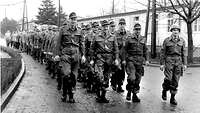
The first conscripts of the new Bundeswehr march through the barracks in Andernach.
Bundeswehr/BaumannHowever, it would have been impossible for the new armed forces in NATONorth Atlantic Treaty Organization to provide 500,000 troops in less than five years solely by recruiting volunteers. Compulsory military service was the only way to achieve this goal. In 1956, the German Bundestag decided to put compulsory military service into effect as of 1 April 1957. As of that date, every male German citizen had to serve in the armed forces unless he refused to render military service on grounds of conscience in accordance with Article 12 of the Basic Law for the Federal Republic of Germany. Conscientious objectors had to perform alternative service.
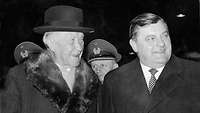
Franz Josef Strauss (on the right), the Federal Minister of Defence at that time, shown here with Federal Chancellor Konrad Adenauer (left), helped shape the process of building up the new Bundeswehr
Bundeswehr/Günther OedEstablishment of the Bundeswehr during the Cold War initially started with training units, schools and a few military elements, which were tasked with both teaching and forming the core of the new armed forces. The Bundeswehr created 56 units in 1956 alone. Nevertheless, there were still only 7,700 military personnel serving in the armed forces by the end of 1956. Most of their equipment came from new partner nations. In particular, the USUnited States provided the Bundeswehr with artillery weapons and several hundred M47 and M48 battle tanks, as well as combat and training aircraft, free of charge.
Nevertheless, the ambitious plan for building up the forces was doomed to failure from the beginning. There were not enough barracks, personnel or housing for the soldiers at the new locations. Federal Minister of Defence Theodor Blank had already resigned in 1956 as a result. His successor was the CSUChristlich-Soziale Union politician Franz Josef Strauss, who discarded the Bundeswehr leadership’s plans for buildup and decided on the principle of “quality over quantity”. For this reason, the Bundeswehr did not reach a force level of approximately 500,000 until the 1960s.
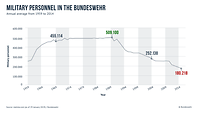
The Bundeswehr’s force level increased rapidly during the Cold War. It was at its highest after German reunification. The end of the Cold War allowed Germany to reduce the number of military personnel.
BundeswehrDuring its buildup, the Bundeswehr experienced a major increase in personnel due to downsizing of the Federal Border Guard. In 1956, the German Bundestag decided that this federal police force had to provide personnel to build up 1 Infantry Division (Hanover) and 2 Infantry Division (Marburg). The maritime border guard was completely absorbed into the new federal navy that was being established. In this way, the Bundeswehr gained around 10,000 trained military personnel of all ranks.
Along with establishment and training, the Bundeswehr’s units and wings also took on their military mission within the scope of national and collective defence. Within the framework of NATONorth Atlantic Treaty Organization’s “forward strategy”, this defence was to start right behind the inner German border from the beginning.
Until 1954, the prevailing principle within NATONorth Atlantic Treaty Organization had still been to organise defence of Europe that would only start at the Rhine. As of 1956, top-ranking German military and political leaders were able to establish the concept that collective defence would also always include defence of Germany.
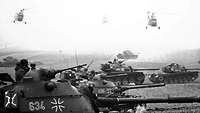
The Bundeswehr conducts the "Panthersprung" exercise in North Hesse, not far from the border to East Germany, in 1967, shown here with M48 battle tanks and Sikorsky H-34 G helicopters
Bundeswehr/Thomas HöpkerStarting in 1957, NATONorth Atlantic Treaty Organization adhered to the strategy of “massive retaliation” (MC 14/2). The Alliance hoped that this strategy would prevent war. In the event of a war, the adversary would have to reckon with immediate, massive employment of nuclear weapons. Because of its deterrent effects, members of the German military also called this strategy “life insurance” for the Federal Republic of Germany.
Nevertheless, “massive retaliation” was not a strategy for warfare, but rather for preventing war. NATONorth Atlantic Treaty Organization had neither a concept nor sufficient conventional means of responding appropriately to regional or limited conflicts.
While the 1962 Cuban Missile Crisis showed that nuclear deterrence could discourage the Soviet Union’s efforts at expansion, the Soviet Union used various means of expanding its influence in other areas, as did the USUnited States. The East-West conflict would soon go on to play a major role in the wars and conflicts in the Arab world, as well as Southeast Asia and Africa.
As a result of NATONorth Atlantic Treaty Organization’s shift to the strategy of “flexible response” in 1967/1968, the Bundeswehr initially had to rethink and reduce its tasks that were primarily geared towards conducting nuclear combat operations. Defence planning was now also based on conventional means. With this strategy, NATONorth Atlantic Treaty Organization also began its dialogue of détente with the Soviet Union. NATONorth Atlantic Treaty Organization’s Harmel Report of 1967 described security as the result of credible defence readiness and the will to achieve détente.
NATONorth Atlantic Treaty Organization planned collective defence with the General Defense Plan. Initiated by the NATONorth Atlantic Treaty Organization’s supreme commander in Europe (SACEURSupreme Allied Commander Europe ), plans that defined the military elements’ tasks in the event of a war were drawn up and reviewed on a regular basis. Within this framework, the German and Allied land forces in the Federal Republic of Germany were assigned special defence zones in which the (nationally led) army corps were to be employed side by side.
Unlike the land forces’ nationally led corps, all of NATONorth Atlantic Treaty Organization’s air forces and the German naval units were integrated directly into the NATONorth Atlantic Treaty Organization structures. Accordingly, all of the Air Force’s combat units, as well as the airspace surveillance forces, were fully subordinate to the NATONorth Atlantic Treaty Organization Command Forces and the Alliance, even in peacetime, from the beginning. This also entailed shift duty in constant readiness.
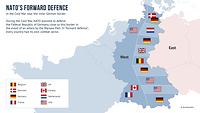
A divided country: West Germany and East Germany were frontline countries of opposing alliances. In the event of an attack, the western part of Germany was to be defended close to the border.
Bundeswehr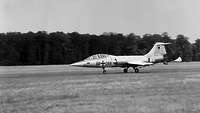
One of the Bundeswehr’s TF-104G Starfighters releases its drogue parachute during landing. The Starfighter was one of the delivery systems within the scope of the Bundeswehr’s nuclear sharing.
Bundeswehr/StorzIn the 1980s, the Bundeswehr had 12 Army divisions with 36 brigades and far more than 7,000 battle tanks, armoured infantry fighting vehicles and other tanks; 15 flying combat units in the Air Force and the Navy with some 1,000 combat aircraft; 18 surface-to-air-missile battalions, and naval units with around 40 missile boats and 24 submarines, as well as several destroyers and frigates. Its material and personnel contribution even just to NATONorth Atlantic Treaty Organization’s land forces and integrated air defence in Central Europe amounted to around 50 percent. This meant that, during the Cold War, by the 1970s, the Bundeswehr had already become the largest Western European armed forces after the USUnited States armed forces in Europe – far ahead of the British and even the French armed forces. In peacetime, the Bundeswehr had 495,000 military personnel. In a war, it would have had access to 1.3 million military personnel by calling up reservists.
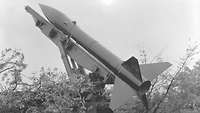
Starting in 1957, the Bundeswehr was equipped with USUnited States Honest John-type artillery field rocket launchers.
Bundeswehr/StrakHowever, in light of the Warsaw Pact’s conventional superiority, NATONorth Atlantic Treaty Organization still had to rely on deterrence with nuclear weapons. They signalled that it was virtually impossible to win an offensive operation against NATONorth Atlantic Treaty Organization, or even to conduct one. Within the scope of “nuclear sharing”, the Bundeswehr had various delivery systems for nuclear payloads from 1956/1957 to 1990. Aside from the Lockheed F-104G Starfighter fighter bombers and the Panavia 200 Tornado aircraft that succeeded them, these delivery systems primarily included various artillery systems: towed howitzers and armoured self-propelled howitzers (203 mm and 155 mm), and Honest John, Sergeant, Lance or Pershing 1a ballistic missiles in the short, medium and intermediate ranges. The payloads for these nuclear “special weapons” were under the control of the USUnited States armed forces in Europe.
Without the Bundeswehr and its some 500,000 military personnel, NATONorth Atlantic Treaty Organization’s national and collective defence in Central Europe would never have been feasible. Nor would it have been feasible to pursue a policy of détente, which was in turn based on this military security.
The Bundeswehr’s importance for the Alliance went beyond its size and striking power. The appointment of German generals to high-level command positions also underscored its importance. The Bundeswehr provided the Commander-in-Chief, Allied Forces, Central Europe (CINCENT) as of 1966/1967 and the Commander of the Fourth Allied Tactical Air Force as of 1976. Starting in the late 1950s, the Bundeswehr also provided the Deputy Chief of Staff, Plans and Operations at NATONorth Atlantic Treaty Organization’s headquarters in Europe (SHAPESupreme Headquarters Allied Powers Europe). By 1990, three German generals had been Chairman of the NATONorth Atlantic Treaty Organization Military Committee, the highest-level military body in NATONorth Atlantic Treaty Organization.
Martin Rink: Die Bundeswehr 1950/55–1989 (= Militärgeschichte kompakt. 6). DeGruyter Oldenbourg, München 2015, ISBN 978-3-11-044096-6.
Rudolf J. Schlaffer, Marina Sandig: Die Bundeswehr 1955–2015. Sicherheitspolitik und Streitkräfte in der Demokratie. Analysen, Bilder und Übersichten. Rombach, Freiburg im Breisgau 2015, ISBN 978-3-7930-9836-2.v